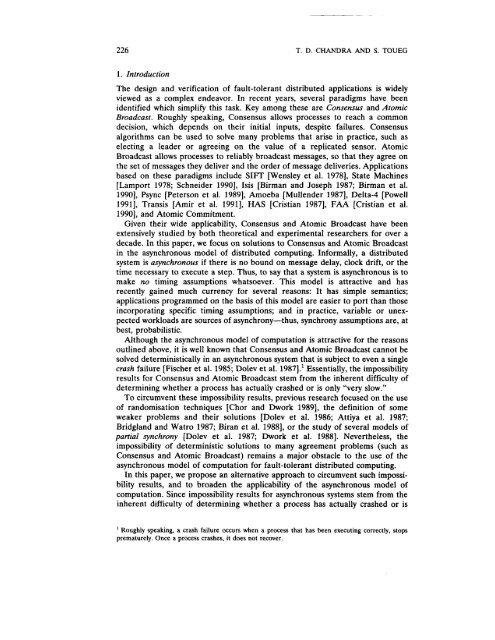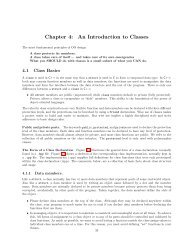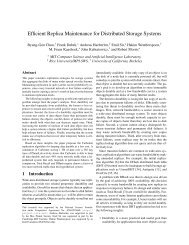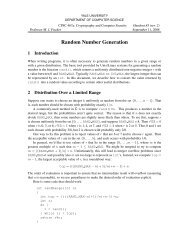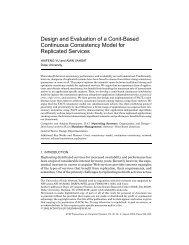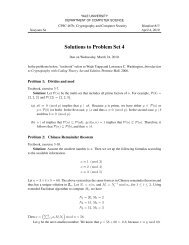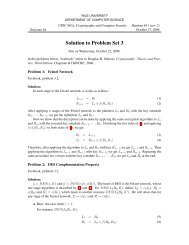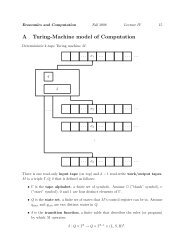Unreliable Failure Detectors for Reliable Distributed Systems
Unreliable Failure Detectors for Reliable Distributed Systems
Unreliable Failure Detectors for Reliable Distributed Systems
Create successful ePaper yourself
Turn your PDF publications into a flip-book with our unique Google optimized e-Paper software.
226 T. D. CHANDRA AND S. TOUEG1. IntroductionThe design and verification of fault-tolerant distributed applications is widelyviewed as a complex endeavor. In recent years, several paradigms have beenidentified which simplify this task. Key among these are Consensus and AtomicBroadcast. Roughly speaking, Consensus allows processes to reach a commondecision, which depends on their initial inputs, despite failures. Consensusalgorithms can be used to solve many problems that arise in practice, such aselecting a leader or agreeing on the value of a replicated sensor. AtomicBroadcast allows processes to reliably broadcast messages, so that they agree onthe set of messages they deliver and the order of message deliveries. Applicationsbased on these paradigms include SIFT [Wensley et al. 1978], State Machines[Lamport 1978; Schneider 1990], Isis [Birman and Joseph 1987; Birman et al.1990], Psync [Peterson et al. 1989], Amoeba [Mullender 1987], Delta-4 [Powell1991], Transis [Amir et al. 1991], HAS [Cristian 1987], FAA [Cristian et al.1990], and Atomic Commitment.Given their wide applicability, Consensus and Atomic Broadcast have beenextensively studied by both theoretical and experimental researchers <strong>for</strong> over adecade. In this paper, we focus on solutions to Consensus and Atomic Broadcastin the asynchronous model of distributed computing. In<strong>for</strong>mally, a distributedsystem is asynchronous if there is no bound on message delay, clock drift, or thetime necessary to execute a step. Thus, to say that a system is asynchronous is tomake no timing assumptions whatsoever. This model is attractive and hasrecently gained much currency <strong>for</strong> several reasons: It has simple semantics;applications programmed on the basis of this model are easier to port than thoseincorporating specific timing assumptions; and in practice, variable or unexpectedworkloads are sources of asynchrony—thus, synchrony assumptions are, atbest, probabilistic.Although the asynchronous model of computation is attractive <strong>for</strong> the reasonsoutlined above, it is well known that Consensus and Atomic Broadcast cannot besolved deterministically in an asynchronous system that is subject to even a singlecrash failure [Fischer et al. 1985; Dolev et al. 1987].1 Essentially, the impossibilityresults <strong>for</strong> Consensus and Atomic Broadcast stem from the inherent difficulty ofdetermining whether a process has actually crashed or is only “very slow.”To circumvent these impossibility results, previous research focused on the useof randomisation techniques [Chor and Dwork 1989], the definition of someweaker problems and their solutions [Dolev et al. 1986; Attiya et al. 1987;Bridgland and Watro 1987; Biran et al. 1988], or the study of several models ofpartial synchrony [Dolev et al. 1987; Dwork et al. 1988]. Nevertheless, theimpossibility of deterministic solutions to many agreement problems (such asConsensus and Atomic Broadcast) remains a major obstacle to the use of theasynchronous model of computation <strong>for</strong> fault-tolerant distributed computing.In this paper, we propose an alternative approach to circumvent such impossibilityresults, and to broaden the applicability of the asynchronous model ofcomputation. Since impossibility results <strong>for</strong> asynchronous systems stem from theinherent difficulty of determining whether a process has actually crashed or is1Roughly speaking, a crash failure occurs when a process that has been executing correctly, stopsprematurely. Once a process crashes, it does not reeover.


